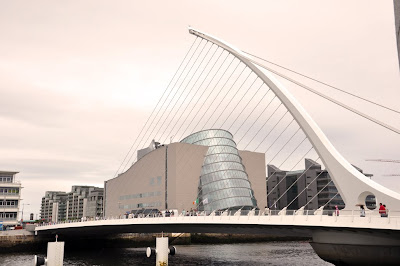Today we were up early (couldn't get out of the awful Travelodge quickly enough, I'll tell you that!) to drive to Belfast, the capital of Northern Ireland and the place where the Troubles started. Our plan for the day was not overly packed, just a tour of the city led by another Aiden (this one financially rather than ideologically driven), lunch at the famous Crown Bar, and a quick tour of the Crumlin Road Jail.
Once again, Claire set us up with a fabulous guide. Aiden II knew his stuff, was brimming with great stories, and told them well. Listening to his banter, it was clear that he is a Catholic, but you wouldn't know it unless you knew what you were looking for (remember, everything is a symbol). Indeed, most of the students thought that he is Protestant because he spent more of the tour in Loyalist areas.

Our first stop was the shipyard where Titanic was built, now being redeveloped as the Titanic Quarter for tourists. We did not get out of the bus, so no photos (sadly).
Next off, Stormont--the political heart of the North.

Let's go back to the symbols idea again quickly. Stormont is the Northern Irish equivalent of the US Capital Building or Britain's parliament at Westminster, but there are key differences. For one thing, if you look at the place from the air, the roads form a Union Jack. For another thing, there is a giant statue of a major Unionist politician, Edward Carson, at the center of that Union Jack. All calculated to make Nationalists feel good about themselves, I'm sure.


With Stormont behind us, we delved into the Loyalist areas of Belfast—looking specifically at the colorful murals that decorate working class neighborhoods. In Unionist areas, the murals are pretty terrifying.



In recent years many local governments in the North started to push for an end to symbols like these. Some even tried to stop Loyalists and Nationalists alike from putting up flags—perhaps the most divisive symbol of all. Evidently this effort is not taking place in Belfast as we saw a Loyalist group putting up flags.

For whatever reason, we did spend more time in Loyalist areas than in the Nationalist Falls Road. Still, we did stop to get some photos of Nationalist murals as well. I particularly like this one... mostly because it looks like a family member if he were to grow a beard. Okay, so that wasn't very intellectual. This mural celebrates the infamous H-Block hunger strikes. In brief, Nationalist prisoners wanted to be afforded the rights of political prisoners including the right to wear their own cloths. When this was not allowed, they started wearing only blankets. When that didn't work they smeared their cells with excrement (the so-called "dirty protest") and when that didn't work, they went on hunger strike in 1981. Ten men died before the British government finally gave in.

Our last major tour stop was the so-called "Peace Wall." When Loyalists and Nationalists failed to get along, the Brits constructed a giant wall between the two communities. It runs for miles and is something like 90-feet high. Today, though things are considerably better in the North, as a cry for the final and total end to conflict, people sign the wall.






Tour over, it was on to the Crown Bar for lunch. This place is the ultimate in high Victorian pub design. It also features great food and some wonderful cask beers.


The ceilings were done by the same craftsmen who did the Titanic.



Finally, it was on to the Crumlin Road Jail we had a tour booked. Funny thing was, when we showed up, the place was under renovation! "What?" you say. Not a very good way to attract return tourists!
Thinking quickly, Claire and I decided to take us to the Ulster Museum for a quick tour. I focused on the history exhibits, but the museum features natural stuff (dinosaurs, for example) as well as two floors of art. An impressive place.
Of course, my great question was how the history would be presented... reasonably well, as it happens.




Once finished, we headed back to Dublin where I did laundry and the students headed out for a final night on the town. Tomorrow is the last day.








 (Okay, so I went a bit overboard shooting the rat... but it was cute and everybody seemed to enjoy hanging with the little guy. Besides, he was giving voice to an important social message: Save the Trash.)
(Okay, so I went a bit overboard shooting the rat... but it was cute and everybody seemed to enjoy hanging with the little guy. Besides, he was giving voice to an important social message: Save the Trash.)























































